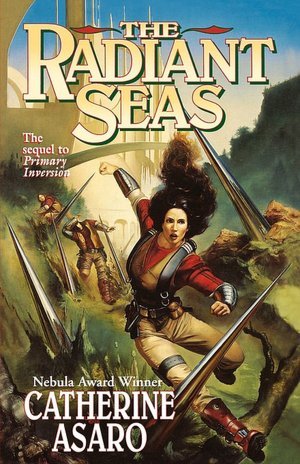
The Radiant Seas by Catherine Asaro is the second book I’ve read in the Skolian Empire saga (which actually has three empires in it with the two main ones having different names so it gets confusing but that’s the term I’m going to stick with). The other book that I’ve read was Primary Inversion which, chronologically, immediately precedes The Radiant Seas. For this review to make sense, I’m going to have to include a spoiler for the end of Primary Inversion, but I’ll put in a warning when I get to that.
Asaro’s universe contains three interstellar empires:
- The Skolians whose ruling family are powerful telepaths and who can communicate instantaneously through a telepathic web that three of the imperial family hold in place with their minds (and to do so they have to be the most powerful type of telepaths, a condition that involves recessive genes and can’t be genetically engineered.
- The Eubians who are ruled by the irredeemably evil (and genetically specific) class of Aristos. Evil because they literally gain transcendent pleasure from being in proximity to the suffering of telepaths. Their mission in life is generally to acquire as many telepathic slaves as they can, the more powerful the better (and, incidentally, they don’t see anyone else as fully human, especially the telepaths but including ordinary humans).
- And then there’s the Earth and Allied Worlds who try to stay out of the never ending conflicts between the other two empires and don’t entirely believe how horrible the Eubians are with their slavery and torture.
The main characters are mostly Skolian and the antagonists are all Eubian although they’re not all as automatically evil as it might seem (but most are) and do have proper motivations for what they do, always an important trait in bad guys. The story in The Radiant Seas picks up exactly where Primary Inversion left off and spans many (17ish) years.
Before I get to the spoilers, a few words on the science because I can’t review an SF book without commenting on that. Asaro’s science, real and made up, is pretty good and (most importantly ;-p ) didn’t annoy me. It was a good mix between made up stuff (the telepathy) told from a scientific point of view and fairly hard semi-plausible science like the propulsion systems. Asaro actually has a PhD in physical chemistry theoretical atomic and molecular physics so much of the quantum and relativity stuff is plausible. She even published a paper about the theory behind her faster than light travel system. In short, nothing to complain about here.
And to be able to talk about the plot, I have to mention a spoiler for the end of Primary Inversion…
 ~
~
SPOILER WARNING FOR PRIMARY INVERSION
***
WARNING OF SPOILERS
***
YOU HAVE BEEN SPOILER-WARNED FOR PRIMARY INVERSION (NOT RADIANT SEAS)
~
At the end of Primary Inversion, Soz, next in line to be the Imperator (Skolian), and Jabriol II, heir to the Imperial throne (Eubian), fall in love when Soz discovers Jabriol isn’t in fact an Aristo but part of a secret genetic experiment to breed telepathy into the imperial line. Rather than feeding on telepaths, he is the most powerful type of telepath himself (as is Soz). Since peace between their empires is inherently impossible while there are still Aristos running around, they ran off to a deserted planet together. The Radiant Seas picks up when they’re busy making copious babies while their families mourn them, then get on with waging war against each other.
Because the story spans so many years, it really felt like the first half was setting up the events of the second half. There were some action scenes in the first half and the story definitely progressed, but there were moments when it felt like it was dragging. In the second half, Soz and Jabriol (and their kids) rejoin civilisation and their respective empires, the story really picks up. Soz trying to rescue Jabriol was much more exciting than them making babies while their families fought.
Aside from the few boring bits (which weren’t enough to ruin anything, in my opinion), I quite enjoyed this novel. I mostly liked Soz because she kicks arse but I did find the whole running away from imperial duties thing a bit selfish. However, it was also nice to see an alternative narrative where duty isn’t held up as the most important thing and the character chooses family. (I still think they should’ve hung around to fix things up more first…)
Overall, I would recommend this book to people who enjoy science fiction with epic world-spanning empires, lots of political intrigue and long range plots. I definitely suggest reading Primary Inversion before The Radiant Seas, however, since a lot of world building and, more importantly, plot set up, takes place in the earlier book.
4 / 5 stars

No comments:
Post a Comment
Note: only a member of this blog may post a comment.